
The Cyperaceae are a family of graminoid (grass-like), monocotyledonous flowering plants known as sedges. The family is large, with some 5,500 known species described in about 90 genera, the largest being the "true sedges" genus Carex with over 2,000 species.

Ornamental grasses are grasses grown as ornamental plants. Ornamental grasses are popular in many colder hardiness zones for their resilience to cold temperatures and aesthetic value throughout fall and winter seasons.

Carex is a vast genus of nearly 2,000 species of grass-like plants in the family Cyperaceae, commonly known as sedges. Other members of the family Cyperaceae are also called sedges, however those of genus Carex may be called true sedges, and it is the most species-rich genus in the family. The study of Carex is known as caricology.

The widow skimmer is one of the group of dragonflies known as king skimmers. The nymphs live in the water, molting and growing until they are ready to emerge from the water and then molting a final time to reveal their wings.
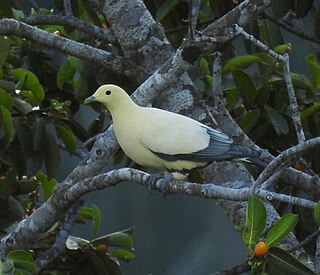
The silver-tipped imperial pigeon, also known as the white imperial pigeon or white-tipped imperial pigeon, is a relatively large species of bird in the family Columbidae. It is endemic to forest, woodland and mangrove on Sulawesi and smaller nearby islands.

The black-and-white seedeater is a species of bird in the family Thraupidae. It is found in Bolivia, Brazil, Colombia, Ecuador, Peru, and Venezuela. Its natural habitats are subtropical or tropical moist shrubland, subtropical or tropical high-altitude shrubland, and heavily degraded former forest.
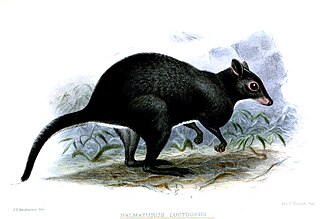
Dorcopsis is a genus of marsupial in the family Macropodidae. The members of the genus are found on the island of New Guinea.

The gray dorcopsis or gray forest wallaby is a species of marsupial in the family Macropodidae. It is found in West Papua and Papua New Guinea.

Abavorana luctuosa, also known as the Malaysian frog, mahogany frog or purple frog, is a species of true frog. It is found in the Malay Peninsula and in Borneo. It was formerly placed in the genus Hylarana.
Vespa luctuosa is a species of hornet which is endemic to the Philippines. The main subspecies is Vespa luctuosa luctuosa. Other known subspecies include Vespa luctuosa luzonensis and Vespa luctuosa negrosensis. Vespa luctuosa is known for its potent venom.

Carex riparia, the greater pond sedge, is a species of sedge found across Europe and Asia. It grows in a variety of wet habitats, and can be a dominant species in some swamps. It is Britain's largest Carex, growing up to 130 cm tall, with glaucous leaves up to 160 cm long. It hybridises with a number of other Carex species, including the closely related Carex acutiformis – the lesser pond sedge. A variegated cultivar is grown as an ornamental grass.
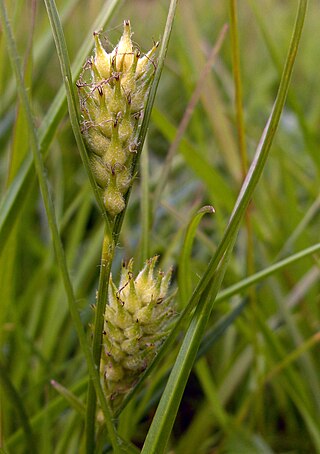
Carex hirta, the hairy sedge or hammer sedge, is a species of sedge native across Europe. It has characteristic hairy leaves and inflorescences, and is the type species of the genus Carex.

Carex sect. Ovales is a section of the genus Carex, containing around 85 species of sedge. It is the most diverse section of the genus in North America, containing 72 species:

Carex subg. Carex is a subgenus of the sedge genus Carex. It is the largest of the four traditionally recognised subgenera, containing around 1400 of the 2000 species in the genus. Its members are characterised by the presence of one or more exclusively male (staminate) terminal spikes, quite dissimilar in appearance from the lateral female (pistillate) spikes below. In most species, the female flowers have three stigmas, but a few species, including Carex nigra, have female flowers with only two stigmas.
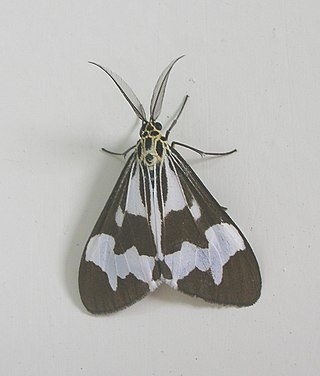
Nyctemera luctuosa is a moth of the family Erebidae first described by Samuel Constantinus Snellen van Vollenhoven in 1863. It is found in Papua New Guinea, Australia and the Philippines. The habitat consists of mountainous areas.

Carex subg. Vignea is a subgenus of the sedge genus Carex, containing around 300 of the 2000 species in the genus. Its members are characterised by having bisexual, sessile spikes, where the female flowers have two stigmas each.
Macropodid alphaherpesvirus 2 (MaHV-2) is a species of herpesvirus in the genus Simplexvirus. It was officially accepted as a valid species by the International Committee on Taxonomy of Viruses in 2004.
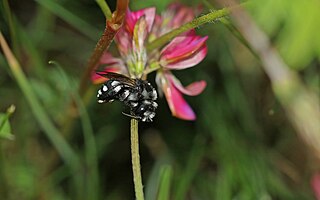
Melecta luctuosa, also known as square-spotted mourning bee, is a species of bee within the family Apidae.













